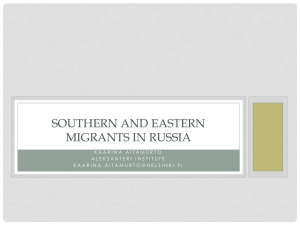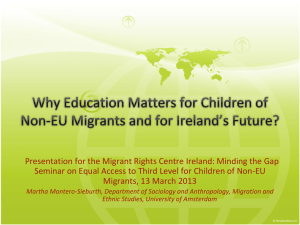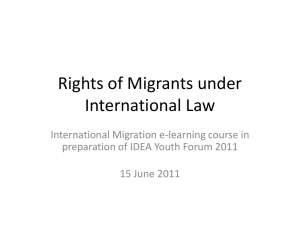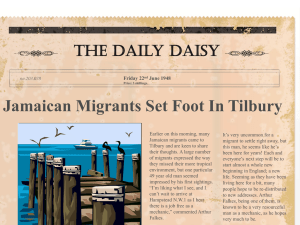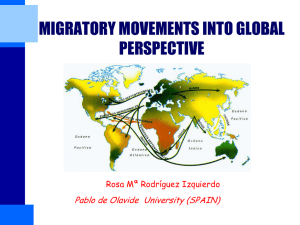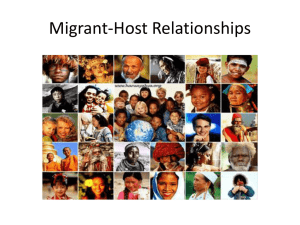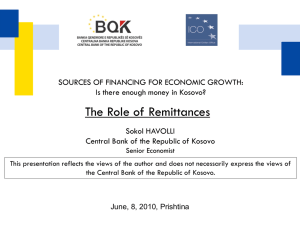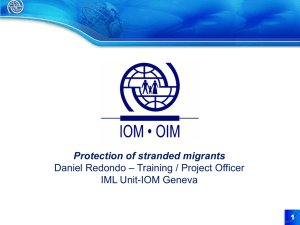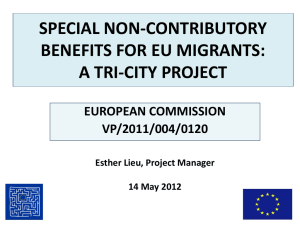New migration and superdiverse neighbourhoods
advertisement
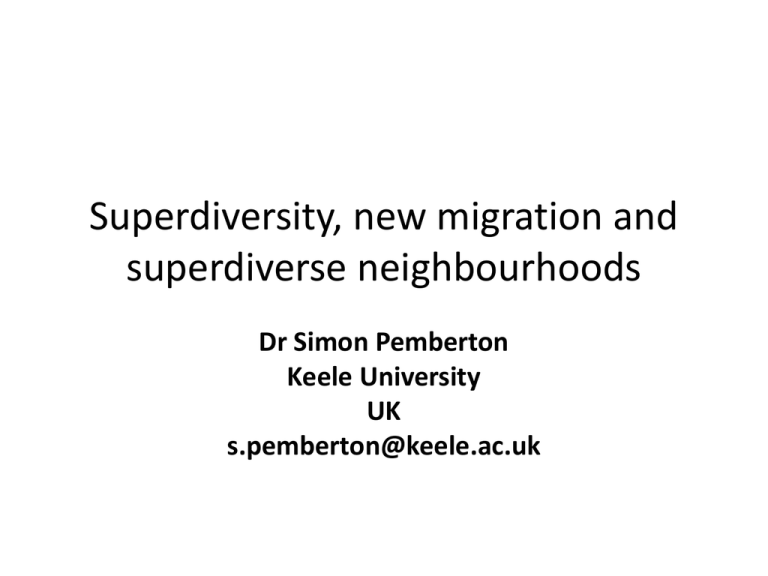
Superdiversity, new migration and superdiverse neighbourhoods Dr Simon Pemberton Keele University UK s.pemberton@keele.ac.uk • First new United Kingdom university of the 20th century (1949). • UK’s largest integrated campus university and occupies a 617 acre estate. • 19th century Keele Hall, has Grade II registration with English Heritage. • c. 10,000 students. • 1,700 staff. The politics of managed migration – EU and UK • “Cameron pledge to restrict migrant benefits” • “It is time for a new settlement which recognises that free movement is a central principle of the EU but it cannot be a completely unqualified one”. (Daily Telegraph 27/11/13) Key proposals: • Migrants stopped from claiming out-of-work benefits for first three months in UK. • Those who do claim now only able to claim benefits for a maximum of six months. • A “minimum earnings threshold”. • Those sleeping rough deported. Germany • • • “Far reaching economic and social consequences of EU freedom of movement laws”. “Only a few are familiar with conventions of neighbourly co-existence”. “Kindergeld” (200 Euros/month vs 16 Euros/month). The politics of managed migration • Lazlo Andor (EU Employment Commissioner) – 27/11/13 “Britain risks being the nasty country of the EU” “Reaction in UK based on hysteria” • UK govt figures 2011/12: only 7% claiming income/employment related benefits (31% EU) Issues • • • • • Poverty migration vs benefit tourism. Spatiality of migration flows. Privileging of certain groups over others. Structure and Agency. Employment, welfare and immigration policy. • The increasing “superdiversity” of migration......... Superdiversity • “Diversity that supersedes anything previously experienced” (Vertovec, 2012). • Emergence of “new” migration early 1990s. • Fragmented – from many migrants from a few countries to a few from many. • Multi-layered – indigenous/old migrant/ new migrant communities. Old and New Migrants in Birmingham 2011 Superdiversity • Complex - no longer just about a limited number of nationalities (country of origin), languages and faith groups. • Not enough to see diversity as just about ethnicity/multiculturalism. • Variety of legal statuses (asylum seekers, refugees, students; labour migrants). • Variety of rights and entitlements. • Variety of mobilities. • Newcomers can be white and can face some of the same challenges as any other migrant. • Living in new places previously untouched by immigration – are “spatial pioneers”. Examples • Since 1990 - >26 million documented migrants have entered the EU15 (Boeri, 2011). • 1.2 million migrants arriving in Australia between 2000 and 2010. • 3.8 million arriving in England and Wales between 2001 and 2011 (ONS, 2012). Examples • Milan - 19% of the population are born overseas and have arrived from 138 different countries (Comune di Milano, 2008). • London (29% from ethnic minority backgrounds, over 170 countries (GLA, 2005). • Amsterdam (45% born overseas, from 170 countries (City of Amsterdam, 2012). Superdiversity by self-declared ethnicity and sub-regions of birth New migration and superdiverse neighbourhoods • Studies on superdiversity associated with new migrant flows. • BUT virtually no attention given to the functional role played by superdiverse neighbourhoods. • What influence do superdiverse neighbourhoods have on residents’ decisions about whether to move to, stay, or remain . . Traditional studies – “Zones of transition” • Majority of newcomers to existing areas of diversity. • Superdiverse contact zones (Robinson et al., 2007), transition zones (Park and Burgess, 1925) or escalator areas (Travers et al., 2007). • Attention on new migrants’ impact upon neighbourhoods – services. • Transition zones often viewed as problematic. • High levels of mobility. • Low levels of property maintenance, and an associated low levels of social cohesion (Travers et al., 2007). Traditional studies - 3 main areas… 1. Structural, individual and ‘area’ influences on locational choices of new immigrants. Related to: • Individual resources of immigrants plus 'area' determinants. • High levels of ethnic diversity, deprivation and private rented housing. • But no reference to superdiverse neighbourhoods as ‘zones in transition’. Traditional studies…… 2.Problems and issues associated with migrant 'place-making' (for example, see Gill, 2010). Issues of : •common identity •Representation •Receptivity •Lack of affinity to existing migrant structures (Gill 2010, 1170). Traditional studies 3. Place experiences / impacts of new immigration. Related to: • Shared norms • Peer influence • Family support • Availability / quality of role models. But……. • Relationship between neighbourhood characteristics and decisions about movement not adequately conceptualized. • Neighborhood effects studies, by their focus on structural factors, often disregard human agency. Robinson (2010): explaining geographical variations in local experiences of new immigration. i) Collective explanations. ii) Contextual explanations. iii) Compositional explanations. Collective • Sociocultural and historical features of communities. • History of norms and values associated with identities. • History and extent of accommodation of diversity and cultural differences. • Extent of shared understandings and practices. • Amount of contact and interaction between different groups. Contextual • Opportunity structures in the physical and social environment. • Levels of deprivation and disadvantage / affluence. • Availability and targeting of resources (such as housing, services and community facilities). • Actions of a range of actors from the public, private and voluntary sectors in facilitating, supporting and mediating the effects of new immigrant arrivals. Compositional • Who lives in a place. • Characteristics of the local population – both established and newly arrived. • Socio-economic circumstances and personal resources of such individuals are important (including financial and social capital). • Ethnic and cultural identity. • Legal status and associated rights, responsibilities and opportunities of new immigrants (BUT informed by policies of ‘managed migration’ by the state). Methods • ‘New’ migrants – arrived in last 5 years. • Those outside EU (Handsworth). • A8 (Kensington and Handsworth). Methods Case Studies BIRMINGHAM LIVERPOOL • 3 main phases: I) Arrival of post-commonwealth migrants in the 1950s to 1970s, II) Dispersal of asylum seekers from 1990 to the present day III) Arrivals of Accession country migrants from 2004. • 41318 migrants from 187 different countries between 2007 and 2010 • Handsworth - long history of diversity and houses residents who have arrived from 170 different countries. • Long history of immigration associated with its role as a 19th Century port. • Population is less ethnically diverse. • However, the ethnic minority population more than doubled between 2001 and 2011 – the fastest increase of any UK city. • Post-commonwealth and EU Accession country migration being prominent. • Kensington - ethnic minorities in the area increasing from 5% in 2001 to over 25% in 2011. • More recently diversifying. Key influences on moving to a superdiverse neighbourhood • Collective – some influence – diversity important for non-EU migrants – avoid racism - but not A8. • Contextual – more important for all. • Cheap property; good transport/access to employment. • But lack of choice important for asylum seekers / A8 workers (housing tied to employment): • We were put up by the Czech work agency. They picked us up at Manchester airport and brought us straight here (Slovakian Woman). Key influences on moving to a superdiverse neighbourhood • ESOL classes attraction for new (nonEU) migrants . • Cultural / religious and retail facilities important for both non-EU migrants and A8s: • There are lots of Polish shops in the area around Rookery Road and Soho Road. We can buy everything we need in the local area. (Polish woman). • Availability of schools and housing to accommodate an extended family were also important for new migrants. Key influences on moving to a superdiverse neighbourhood • Compositional - new nonEU migrants in Handsworth and A8s in Kensington mentioned the importance of friends and family. • Help to settle vs access to cheap housing. • Sharing to reduce rent contributions was a pragmatic strategy. Key reasons for staying in a superdiverse neighbourhood • Collective features – continue to be important - less subject to racism and discrimination a major reason to stay. • Where had begun to move - colocating to avoid racism. • Contextually - requirement to minimize rental payments still important • Accessibility to transport and proximity to work too. • New factor - maintaining stability of children’s education. Key reasons for staying in a superdiverse neighbourhood • Some A8 migrants in Kensington had invested in maintaining their rented properties. • Presence of local religious facilities proved to be slightly more important for A8 and non-EU migrants in Handsworth. • Key difference - importance placed on the presence of ethnic businesses, shops, access to a local GP and the availability of places to meet for non-EU migrants compared to those from the A8. • Differential ability to utilize such infrastructure? Key reasons for staying in a superdiverse neighbourhood • A8 businesses more recent and less traction in terms of migrants’ decisions to stay. • A8s less inclined to register with a local GP (A+E). • In Kensington, A8 migrants highlighted local environment as a reason to remain – surprising? • Compositional - opportunity to remain with family or extended families: • The house next to mine, my wife's sister lives there. The house opposite to mine, my wife's sister lives there. The house next to that house, another sister of my wife again! …. In the next street there is my mother-in-law with her English partner and in another house in the next street is who?... My wife's grandma! (Czech Man). • Friends / ability to mix with individuals with similar social class, ethnicity or religious beliefs Key influences on moving from superdiverse neighbourhood • Collective explanations for moving from superdiverse neighbourhoods - did not feature widely. • But A8 migrants uncomfortable with “too much diversity” and intra-community tensions: • “UK is very diverse, a problem for some Poles. Polish men find it difficult to mix there is a little bit of racism, they do not view BMEs in a good light” (Polish Man). • “I am increasingly unhappy about the relationships in this house, with my (migrant) neighbours. The tension is strong and I am thinking about moving to another place” (Polish Woman). • Non-EU migrants - cited examples where there had been conflict, between “Blacks and Arabs and Asians and Blacks” (Kurdish Man). Key influences on moving from superdiverse neighbourhood • Contextual - four main commonalities across both areas and each group of migrants: 1) the need to move to access employment; 2) for addressing housing needs (non-EU family; A8 – minimise cost); 3) for a better environment. 4) to escape feelings of being unsafe. • These issues are inter-related. Key influences on moving from superdiverse neighbourhood • Fundamental issue - feeling unsafe - moves beyond opportunity structures per se. • You say you live in Handsworth and they say: ‘my God how can you live there’….the reputation is scary (African Woman). • Handsworth concerns based on reputation, but in Kensington some A8 migrants had been physically attacked. • Compositional explanations - few individuals in either area suggesting that family or friend relations impinged on decisions to leave. • But willing to move away to access better quality schooling. Implications • All three explanations feature in the decision making of non-EU and A8 migrants but varies. • Categorisation overlooks individual nuances. • Early stages - McDowell (2009, p.27) – ‘whiteness’ of A8 migration and consequent invisibility – easier blending. • Later stages – while non-EU migrants actively sought to move out to other diverse areas, A8s were keen to move away from diversity. Implications 1 • Robinson’s (2010) framework less helpful to comprehend agentic responses to particular situations. • Mechanism to understand emotional and psychological responses? • Adaptation processes to different types of stress / adversity / threat? 1) seek to change the environment; 2) adapt their behaviour by moving or attempting to ‘blend in’; 3) undergo a process of cognitive change by thinking differently perhaps 'hunkering down‘. • ‘Help seeking’ of new migrants may vary by place and require different institutional responses. Implications 2 • Contextual features offer greatest potential for targeting by policymakers – housing; employment availability; cultural facilities. • But need to be coupled with collective features openness to diversity and difference. • Such attitudes not manufactured overnight. • Compositional factors (“people like me”) can provide language skills/ cultural knowledge needed when settling in. Implications 3 • Rather than stabilise, invest in creating quality transition zones. • Help people find their feet quickly before they return home or move to other, more stable, areas. • Planners to plan and accommodate for change rather than stability (Porter and Davoudi, 2012). • Focus on superdiverse neighbourhoods that are “truly ‘in transition’ (Downey and Smith 2011, 39). Final thoughts 1. Concept of superdiversity currently doesn’t figure at national government level. Simplicity not complexity. 2. Non-jargonistic, practical and policy-relevant reports / information required. 3. Planning policies and practises increasingly flexible. 4. Acknowledge that ‘superdiversity’ can have positive/negative connotations. 5. ‘Asset’ based model of superdiverse communities, rather than ‘deficit’ one. • “In a city like Birmingham, which is home to more than 180 nationalities, we need to take a broader planning approach. Places of worship, public spaces, education and health resources, and housing and employment opportunities shouldn’t be designed on a neighbourhood-byneighbourhood basis. Instead we need to ensure that our super-diverse, city-wide population can access these resources wherever they are, but at the same time acknowledging that not everyone currently has the capacity or ability to do so.”

